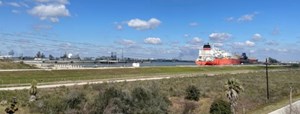U.S. LNG producers poised to leapfrog rivals with three new projects
At least three proposed U.S. LNG export plants have likely found enough customers to receive financial approvals this year, according to Reuters calculations, developments that would make the country the world's largest LNG exporter for years to come.

After a dearth of plant approvals last decade, developers have secured dozens of long-term contracts to finance new multibillion-dollar LNG plants. The pace of approvals has accelerated as Europe has shifted away from Russian gas since Moscow's invasion of Ukraine.
About a dozen developers hope to make final investment decisions (FID) this year. Many of these projects have been delayed several times, but analysts said at least three have secured enough customers to move ahead soon.
The U.S. was long an importer of LNG, but natural gas discoveries and production from the shale revolution flipped the country into an LNG exporter in 2016. U.S. LNG exports hit 10.6 Bft3d in 2022, making the country the second biggest LNG exporter behind Australia.
Projects best positioned to move ahead include Sempra Energy's Port Arthur plant in Texas, Energy Transfer LP's Lake Charles in Louisiana and NextDecade Corp's Rio Grande in Texas.
They have all or most of the long-term LNG sales agreements needed to convince bank's that the projects are ready for debt financing, say analysts.
Sempra said in January it has sold all the capacity needed to advance the first phase of Port Arthur. Buyers include Poland's Polski Koncern Naftowy Orlen SA, U.S. oil producer ConocoPhillips and Germany's RWE AG.
NextDecade has signed deals for about 64% of the first phase of Rio Grande and may soon push it to about 87%, according to analysts at Morgan Stanley, a bank. Rio Grande's customers include ExxonMobil, Shell, Portugal's Galp Energia and Japan's Itochu.
NextDecade could secure a financial go-ahead in the second half of this year, Morgan Stanley said. NextDecade has said that it was targeting a first-quarter FID for the project's first phase.
Energy Transfer signaled on Wednesday it might miss its first-quarter target for a FID due to extreme competition for LNG buyers. It has deals to sell LNG to several firms, including Shell, China's ENN Group and Swiss commodity trader Gunvor.
It takes roughly four years to build these giant plants, so their LNG is not likely to reach markets before 2027. But their production volumes will allow the U.S. to remain ahead of output from Australia and Qatar.
The U.S. already has the capacity to produce the most LNG in the world and would have been the biggest exporter if not for the shutdown of Freeport LNG's plant in Texas after a fire in June 2022.
"The United States still sits atop the ranking of global LNG supply additions through 2030 ... followed by Qatar, Mozambique, and Canada," analysts at energy consultancy Tudor Pickering Holt & Co said in a note.
The U.S. should export around 11.8 Bft3 this year and 12.6 Bft3 next, estimates the U.S. Energy Information Administration. The seven U.S. export plants already in service, including Freeport LNG, can turn about 13.8 Bft3d of gas into LNG.
The next U.S. LNG plants expected to open are the QatarEnergy-Exxon joint venture at Golden Pass in Texas in late 2024, the first phase of Venture Global LNG's Plaquemines in Louisiana in 2024-2026, and Cheniere Energy Inc's expansion at its Corpus Christi plant in Texas in 2025.
Related News
Related News

- ExxonMobil halts 1-Bft3d blue hydrogen project in Texas
- 236-mile Texas-to-Gulf pipeline reaches FID in $2.3-B LNG expansion push
- Bechtel shares findings of tragic accident at Port Arthur LNG facility
- Aramco and Yokogawa commission multiple autonomous control AI agents at Fadhili gas plant
- Ukraine will resume gas imports via Transbalkan route in November



Comments